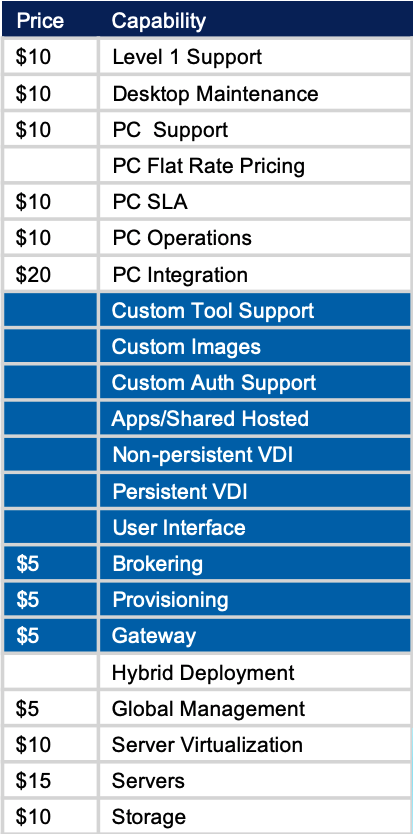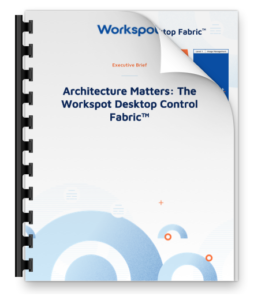The Giant Leap from Legacy VDI to Cloud Desktop Fabric
In a recent post, we delved into the Cloud Desktop Fabric™, the architecture for delivering high-performance virtual desktops at the edge of the cloud. Where did this concept come from? (Hint: It definitely did not come out of an ivory tower!). The story begins back in the early days of VDI, and it’s rooted in the real-world struggles enterprise organizations have faced with deploying and managing virtual desktops. Here’s where we’ve been (most of you have lived at least part of this journey!) and more importantly, what’s possible now.

Legacy On-Premises VDI (2008 – now)
When VDI first appeared in 2008, it was mission-critical packaged software. Today, customers still buy perpetual licenses, acquire servers & storage, and usually hire an integrator to create the solution. Then the really hard part begins; they have to run the stack either by themselves or they hire a service provider to do it for them. Legacy VDI is a complex, do-it-yourself (DIY) software stack that is built for a single customer and typically runs in a single data center. In Figure 1, we have listed the various capabilities of the VDI stack, along with the price per user, per month for each capability. Customers spend between $30-$40 per user per month on the infrastructure (servers, storage, network) required, plus they spend between $10-$20 per user, per month for the VDI software stack. Then the customer spends $50-$70 per user, per month for integrating and operating the stack. That adds up! Our experience is that the OpEx just keeps going up over time because of the complexity of managing the legacy stack.
Of course, faced with the complexity of setting up and managing this stack themselves and the high costs that come with it, it’s not surprising that customers yearned for simple, SaaS VDI – like Salesforce is to CRM. Unfortunately at this time, Microsoft Windows desktop licensing did not permit running Windows desktops on shared infrastructure. This prevented anyone from delivering the service that would solve the complexity and high costs customers suffered.
Figure 1: Legacy VDI complexity
Legacy Desktop-as-a-Service (2014-now)
One of the first Desktop-as-a-Service solutions was launched by Amazon in 2014. Since nobody could run Windows 7 in the public cloud because of the licensing issue, Amazon offered single user Windows Server 2012 as the base operating system. The solution was architected like a modern SaaS platform – it was multi-tenant and turnkey. Critically, they chose to run the Windows Server OS in single-user mode versus the more common shared session-mode that most customers and service providers had been running until that time. Even though the underlying OS was a server operating system, it did not suffer from the myriad app compatibility issues of a multi-session environment. However, it was still a Windows Server – a Windows 7 “experience” – and not the actual Windows 7 desktop version that most customers run on their PCs.
Broker-as-a-Service (2015-now)
We launched our first VDI solution in late 2015. It was a multi-tenant SaaS service that delivered the key software components of VDI as a service – popularly called “broker as a service.” At the time it was a massive innovation in the VDI space. The service was revolutionary for customers in that it eliminated complexity for IT teams tasked with deploying a complex VDI software stack, and enabled them to achieve astonishingly fast time-to-value, not to mention a significant drop in the OpEx associated with managing legacy VDI. Since the Windows desktop licensing restrictions were still in place at this time, we were unable to launch what customers really needed: A turnkey cloud VDI service. The feedback from customers was “meh – you have solved 20% of my problem.” 80% of customer problems were still unsolved. That’s because with broker-as-a-service, the customer still needs to buy infrastructure, integrate infrastructure and operate infrastructure. Although we could not solve the remaining VDI infrastructure challenges (because of those Microsoft licensing restrictions!), we were able to be forward-thinking about what we believed to be inevitable: The ability to provide VDI as a turnkey service on Azure. Therefore, we moved ahead to battle-test many components of our next innovation – a cloud VDI service that takes the heavy-lifting off the shoulders of IT folks. For example, we made sure we could conduct seamless upgrades to all components of our service stack – including clients – with zero downtime. We perfected the customer success and agile development processes that would allow us to receive customer requirements and then roll them out as new features within days or weeks – not the months or years the VDI industry typically sees.
Cloud Desktop Fabric (2017-now)
We became aware of Microsoft’s intention to enable Windows desktop licensing on Azure in mid-2016, and because of all the efforts of our development team, we were ready! We launched our turnkey cloud VDI service at the same time as the Windows 10 licensing became available in Azure in March 2017. Now, customers can deploy persistent and non-persistent Windows 10 desktops in any of the existing 54+ (and any future) regions of Azure around the world. Initial deployment can take as little as a few days, and you can add cloud desktops and GPU workstations around the globe in minutes. Workspot Cloud VDI is a global, enterprise-customizable, turnkey cloud desktop service. No one else could do this in 2016, and to this day, that is still the case. The Cloud Desktop Fabric for Cloud VDI is what enables large, enterprise organizations to meet their requirements. Our service supports their custom requirements for images, authentication, and the use of their desktop management tools. That’s how we avoid disrupting existing IT processes; we just make everything much easier! For organizations with remote employees and contractors, the Global Desktop Fabric architecture is fundamental to ensuring their globally distributed workforces have secure access to apps and data – no matter where they need to conduct business – and that the performance these people experience keeps them productive and happy.
So where we were a decade ago was not such a pretty picture. Today other vendors still offer old-school, on-premises VDI, broker-as-a-service and old-school DaaS. Workspot took a giant leap beyond those products. Our Cloud Desktop Fabric for Cloud VDI architecture is a momentous innovation for customers. The world of IT and enterprise business today is complicated enough; you need information technology that helps you get back to business rather than micro-managing tech. In that sense, Workspot is an impressive business growth tool, because it removes opportunity boundaries, so you’re free to grow!
Figure 2: The Journey from Legacy VDI to the Cloud Desktop Fabric for VDI
Ready to talk about your enterprise requirements? Schedule a demo and let’s explore!




